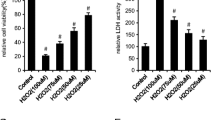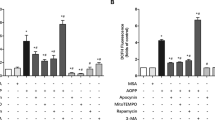Abstract
Deficiency of zinc plays an important role in the pathogenesis of osteoporosis; however, the underlying mechanism is not well understood. Apoptosis of osteoblast causing the loss of bone mass is an important event in the osteoporosis. In this article, we investigated whether zinc deficiency would induce cell apoptosis in MC3T3-E1 cells and ask if it is involved in mitochondrial-mediated pathway. Significant increased apoptosis were observed in zinc deficiency group (ZnD: 5 μM TPEN and 1 μM zinc) compared with untreated control or zinc adequacy group (ZnA: 5 μM TPEN and 15 μM zinc). The mitochondrial membrane potential was strikingly reduced in ZnD group. Furthermore, we observed that the levels of Bax in mitochondria fraction and cyto c, AIF, and cleaved caspase-3/-9 in cytosol fraction were increased in ZnD group. We proposed that zinc deficiency would induce the translocation of Bax into mitochondria, which could lead to the reduction in mitochondrial membrane potential as well as the increase in mitochondrial membrane permeability. In addition, cyto c and AIF were released from mitochondria into the cytosol, which finally activated caspase-dependent and caspase-independent apoptosis processes in MC3T3-E1 cells. Our findings suggested that zinc deficiency is capable of inducing apoptosis through a mitochondria-mediated pathway in osteoblastic cells.





Similar content being viewed by others
References
Yamaguchi M (2010) Role of nutritional zinc in the prevention of osteoporosis. Mol Cell Biochem 338:241–254
Ryz NR, Weiler HA, Taylor CG (2009) Zinc deficiency reduces bone mineral density in the spine of young adult rats: a pilot study. Ann Nutr Metab 54:218–226
da Cunha Ferreira RM, Marquiegui IM et al (1989) Teratogenicity of zinc deficiency in the rat: study of the fetal skeleton. Teratology 39:181–194
Kwun IS, Cho YE, Lomeda RA et al (2010) Zinc deficiency suppresses matrix mineralization and retards osteogenesis transiently with catch-up possibly through Runx 2 modulation. Bone 46:732–741
Otsuka M, Oshinbe A, Legeros RZ et al (2008) Efficacy of the injectable calcium phosphate ceramics suspensions containing magnesium, zinc and fluoride on the bone mineral deficiency in ovariectomized rats. J Pharm Sci 97:421–432
Lytras A, Tolis G (2007) Assessment of endocrine and nutritional status in age-related catabolic states of muscle and bone. Curr Opin Clin Nutr Metab Care 10:604–610
Gur A, Colpan L, Cevik R et al (2005) Comparison of zinc excretion and biochemical markers of bone remodelling in the assessment of the effects of alendronate and calcitonin on bone in postmenopausal osteoporosis. Clin Biochem 38:66–72
Armour KJ, Armour KE, van’t Hof RJ et al (2001) Activation of the inducible nitric oxide synthase pathway contributes to inflammation-induced osteoporosis by suppressing bone formation and causing osteoblast apoptosis. Arthritis Rheum 44:2790–2796
Kim SH, Yoo CI, Kim HT et al (2006) Activation of peroxisome proliferator-activated receptor-gamma (PPARgamma) induces cell death through MAPK-dependent mechanism in osteoblastic cells. Toxicol Appl Pharmacol 215:198–207
Sorice M, Circella A, Cristea IM et al (2004) Cardiolipin, its metabolites move from mitochondria to other cellular membranes during death receptor-mediated apoptosis. Cell Death Differ 11:1133–1145
Dewson G, Kluck RM (2009) Mechanisms by which Bak and Bax permeabilise mitochondria during apoptosis. J Cell Sci 122:2801–2808
Sheridan C, Delivani P, Cullen SP et al (2008) Bax- or Bak-induced mitochondrial fission can be uncoupled from cytochrome C release. Mol Cell 31:570–585
Slee EA, Harte MT, Kluck RM et al (1999) Ordering the cytochrome c-initiated caspase cascade: hierarchical activation of caspases-2, -3, -6, -7, -8, and -10 in a caspase-9-dependent manner. J Cell Biol 144:281–292
Twiddy D, Brown DG, Adrain C et al (2004) Pro-apoptotic proteins released from the mitochondria regulate the protein composition and caspase-processing activity of the native Apaf-1/caspase-9 apoptosome complex. J Biol Chem 279:19665–19682
Norberg E, Orrenius S, Zhivotovsky B (2010) Mitochondrial regulation of cell death: processing of apoptosis-inducing factor (AIF). Biochem Biophys Res Commun 396:95–100
Fehlberg S, Gregel CM, Göke A et al (2003) Bisphenol A diglycidyl ether-induced apoptosis involves Bax/Bid-dependent mitochondrial release of apoptosis-inducing factor (AIF), cytochrome c and Smac/DIABLO. Br J Pharmacol 139:495–500
Adamo AM, Zago MP, Mackenzie GG et al (2010) The role of zinc in the modulation of neuronal proliferation and apoptosis. Neurotox Res 17:1–14
Steiger-Barraissoul S, Rami A (2009) Serum deprivation induced autophagy and predominantly an AIF-dependent apoptosis in hippocampal HT22 neurons. Apoptosis 14:1274–1288
Zhao Y, Tan Y, Dai J et al (2011) Exacerbation of diabetes-induced testicular apoptosis by zinc deficiency is most likely associated with oxidative stress, p38 MAPK activation, and p53 activation in mice. Toxicol Lett 200:100–106
Chou SS, Clegg MS, Momma TY et al (2004) Alterations in protein kinase C activity and processing during zinc-deficiency-induced cell death. Biochem J 383:63–71
Jung JI, Lim SS, Choi HJ et al (2006) Isoliquiritigenin induces apoptosis by depolarizing mitochondrial membranes in prostate cancer cells. J Nutr Biochem 17:689–696
Norberg E, Gogvadze V, Ott M et al (2008) An increase in intracellular Ca2+ is required for the activation of mitochondrial calpain to release AIF during cell death. Cell Death Differ 15:1857–1864
Wessel D, Flügge UI (1984) A method for the quantitative recovery of protein in dilute solution in the presence of detergents and lipids. Anal Biochem 138:141–143
Cho YE, Lomeda RA, Ryu SH et al (2007) Cellular Zn depletion by metal ion chelators (TPEN, DTPA and chelex resin) and its application to osteoblastic MC3T3–E1 cells. Nutr Res Pract 1:29–35
Tomasello F, Messina A, Lartigue L et al (2009) Outer membrane VDAC1 controls permeability transition of the inner mitochondrial membrane in cellulo during stress-induced apoptosis. Cell Res 19:1363–1376
Baek D, Nam J, Koo YD et al (2004) Bax-induced cell death of Arabidopsis is meditated through reactive oxygen-dependent and -independent processes. Plant Mol Biol 56:15–27
Kondo K, Obitsu S, Ohta S et al (2010) ly(ADP-ribose) polymerase (PARP)-1-independent apoptosis-inducing factor (AIF) release and cell death are induced by eleostearic acid and blocked by alpha-tocopherol and MEK inhibition. J Biol Chem 285:13079–13091
Gogvadze V, Norberg E, Orrenius S et al (2010) Involvement of Ca2+ and ROS in alpha-tocopheryl succinate-induced mitochondrial permeabilization. Int J Cancer 127:1823–1832
Shi Y (2002) Mechanisms of caspase activation and inhibition during apoptosis. Mol Cell 9:459–470
Lauber K, Appel HA, Schlosser SF et al (2001) The adapter protein apoptotic protease-activating factor-1 (Apaf-1) is proteolytically processed during apoptosis. J Biol Chem 276:29772–29781
Cregan SP, Dawson VL, Slack RS (2004) Role of AIF in caspase-dependent and caspase-independent cell death. Oncogene 23:2785–2796
Acknowledgments
This study was supported by the National Natural Science Foundation of China (No. 30771813) and the Natural Science Foundation of Liaoning Province.
Author information
Authors and Affiliations
Corresponding author
Additional information
Baolei Guo and Maowei Yang contributed equally to this study.
Rights and permissions
About this article
Cite this article
Guo, B., Yang, M., Liang, D. et al. Cell apoptosis induced by zinc deficiency in osteoblastic MC3T3-E1 cells via a mitochondrial-mediated pathway. Mol Cell Biochem 361, 209–216 (2012). https://doi.org/10.1007/s11010-011-1105-x
Received:
Accepted:
Published:
Issue Date:
DOI: https://doi.org/10.1007/s11010-011-1105-x




